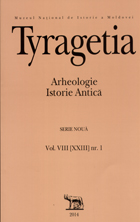Cercetări geospaţiale şi arheologice în microzona Horodişte-Ţipova (raionul Rezina, Republica Moldova)
Geospatial and archaeological research in the micro-zone of Horodişte-Tipova (district Rezina, Republic of Moldova)
Author(s): Ion Niculiţă, Aurel ZanociSubject(s): Archaeology
Published by: Muzeul Naţional de Istorie a Moldovei
Keywords: Horodişte-Tipova micro-zone; orthophotoplan; fortification
Summary/Abstract: From the right bank of the Dniester, north of the village of Ţipova (Rezina District) begins a deep gorge with steep slopes. Near the village of Horodişte the gorge divides, forming a network of canyons which, in turn, outline a series of headlands.As a result of study of orthophotoplans and archaeological reconnaissance in the micro-zone there was discovered an "agglomeration" of sites, consisting of six fortifications (Horodişte „La Cot", Horodişte „La Şanţ", Horodişte II, Buciuşca II, Buciuşca III, Ţipova III ) and two unfortified settlements.In order to investigate the defense system and to determine the period of its functioning at Horodişte „La Cot" and Horodişte „La Şanţ" an archeological research was carried out. As a result, it was found that these fortified settlements were surrounded by "walls" consisting of two wooden facings with a filling of earth and stone.The archaeological materials recovered from the filling of the "walls" indicate that the fortification of Horodişte „La Şanţ" functioned during the early Hallstatt (Cozia-Saharna culture), and one of Horodişte „La Cot" - in the 4th - 3rd centuries BC.Based on the compact arrangement of fortifications and unfortified settlements in the micro-zone of Horodişte-Tipova, it can be assumed the existence of some formation in this space, the "administrative center" of which was the fortress of Horodişte "La Cot". The period of its existence is still not clear. But if we take into account that most of the fortified and unfortified settlements in the Middle Dniester region functioned since the early Iron Age, it can be assumed that the community of the Horodişte-Tipova area settled down here around that time. However, it reaches its peak of development in the 4th - 3rd centuries BC, as well as neighboring communities around Saharna.
Journal: Tyragetia (Serie Nouă)
- Issue Year: VIII/2014
- Issue No: 1
- Page Range: 235-252
- Page Count: 18
- Language: Romanian

